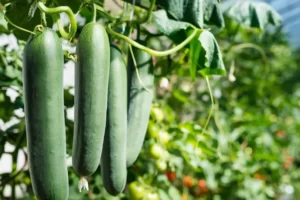BEST CULTIVATION TIPS FOR GARLIC
In India you can say without garlic our food is incomplete. This is an important ingredient for our food & vegetables. Garlic also play a vital role to maintain our health in good conditions. Without this ingredient we have incomplete our food. Few important secrets benefits to eat Garlic as mention below:

BENEFITS OF EATING GARLIC
- Helps to keep the heart healthy
- Help to get rid of high BP
- Helps in curing abdominal diseases
- Improves immunity
- Helps to digest better
- Gives relief from toothache
- Gives relief in cold and cough during winters.
- Garlic improves cholesterol , hence reducing the risks of heart diseases.
- Garlic carries many ox oxidants which may help prevent Alzheimer, dementia .
- Reduces fatigue and enhances work capacities.
- It helps to detoxify many heavy metals of the body.
- Garlic improves bone health and makes it stronger.
- Black garlic may help in protecting brain health.

Few Things About Garlic
The scientific name for garlic is Allium sativum. It has long grass-like leaves which are flat and contain a papery hood around the flower. It is a herbaceous ,annual plant. It has many medicinal benefits and can cure many diseases. The stalk of this plant rises directly from the flower bulb . It is also used as food and medicine. The bulb is made up of many smaller bulbs covered with a papery skin called cloves. An amazing fact about garlic is that it is known as ‘Stinking rose’ and it actually belongs to the lily family.
Active components like amino acid called alliin and enzyme called allinase are present in fresh garlic which is responsible for its strong smell when chewed, chopped, cut , smashed ,etc. They have a variety of healing properties in them.
Garlic contains a wide range of trace minerals like iron , magnesium ,germanium, selenium, copper and zinc. A soil rich in these minerals will provide a healthful bulb of garlic full of these minerals, whereas depleted soil will produce a depleted product.
HOW TO GROW GARLIC ?
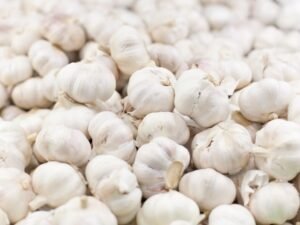
- Best climate requirement for production of garlic
Although garlic grows under a wide range of climates , it can not be grown under too hot or too cold climate. It grows best in medium temperatures in summer as well as in winters. Extremely hot and long dry periods are unfavorable conditions for the formation of the bulb. It requires a cool and moist period during the growth age and dry periods during the maturity of the bulb. This makes it to be known as a frosty -hardy plant.
The bulbing formation takes place in long and high temperatures. The average temperature of 25°- 30°C is considered the most helpful for bulb formation. The bulb formation may hasten if there is an exposure of the young plants to temperatures less than 21°C for one or two months. However ,a prolonged exposure to lower temperature may reduce the yield of the bulbs.
Day length required for the formation of bulb in long day garlic is 13 – 14 hours and for short day garlic is 10 – 12.
Soil requirement for cultivation of the garlic
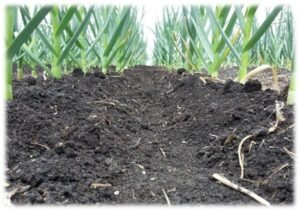
Loam soil is considered the best for the cultivation of this spice crop. It can be produced from sandy loam to clay soil.
Soil having a good amount of drainage and a good carbonic material ,is considered the best for the crop.
The growth of tubers is not possible because of sandy soil which decreases or reduces the yield . The pH of the soil must be 6.0 – 7.5 for it to be suitable for garlic production.
A great amount of nitrogen is required by the crop . Sometimes, it is even more than what most of the farmers think. Manures like, Cow and poultry dung are the best means of adding nitrogen to the plant artificially. Minerals like Sulphur, potassium , gypsum etc. are required for better growth and flavor and also for developing healing properties.
VARIETIES OF GARLIC
There are a number of varieties of garlic grown in different regions. Some of these are as follows:
- Agrifound Parvati-1
- Agrifound Parvati-2
- Agrifound White
- Ooty -1
- G-41
- Yamuna safed-1
- Yamuna safed-2
- Yamuna safed-3
- Yamuna safed-4
- Pant lohit
- Bhima purple
- Bhimaomkar
- Godavari
- Shweta
- PhuleBaswant
- GG -4
- VL garlic -1
- VL lahsun -This will be a good fun fact that since Yamuna safed-2 and Agrifoundparvati have big cloves , they are used for exports.
LAND PREPARATION OF CULTIVATION OF GARLIC
It is necessary to have well drained and moist soil for the cultivation of garlic . Since, moisture is the pre- requisites of garlic cultivation this has to be a mandatory condition. The land in which garlic is to be cultivated ,must be well- ploughed. It must be free of clods and other debris. It is advisable to hoe the land properly so that the residue reaches deep down the soil and gets enhanced decomposition . To plough the land bars can be prepared in 15 cm space and planting should be done in 7.5 cm space.

Seed rate – 1750 kg / ha
When to sow the seeds?
The exact time to sow the seed depends only on the area, soil and climate of the region. To improve the yield of karpooram the best time is the month of April- – May and for kanipakam October – November is considered the best time. These are for northern India and for hilly regions the March-April is the right time ( conditions applied).
In India , garlic is planted as both a kharif and rabi crop. The regions where it is planted as rabi are Andhra Pradesh , Bihar ,Haryana , Uttar Pradesh , Orissa , Punjab , Uttrakhand , Rajasthan , Bengal and other hilly regions .
It is both a rabi and kharif crop in Tamil Nadu , Karnataka ,Gujrat , Maharashtra , Madhya Pradesh and Chhattisgarh.
There are three methods available to garlic sowing :-
- Dibbling
- Furrow planting
- Broadcasting
- As per drip method
After the land is fully prepared ,one should add properly decomposed FYM @ 10 -20 tonnes per hectare as garlic responds more to organic manure.
IRRIGATION SYSTEM OF GARLIC CULTIVATION
Before planting , the land must be given light irrigation. Then ,the very first irrigation must be done immediately after sowing the seeds in the summer season.
There are three methods used for irrigation of garlic:-
- Drip irrigation
- Sprinkler irrigation
- Furrow irrigation
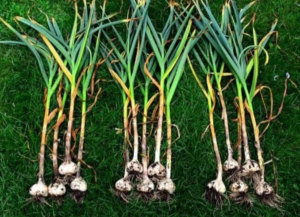
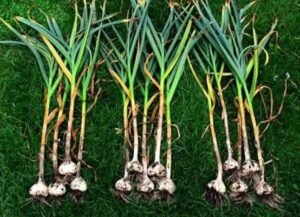
The land must be irrigated every 10 – 15 days. The land must be irrigated well ,when the flakes become visible or start growing. This will help in improving the yield considerably.
It should be kept in view that too much wat supply may result in water stress and lead to splitting of the bulb. However, too little water may under develop the bulbs.
To get best yield you need to adopt Micro Irrigation method for the garlic cultivation. You need to irrigate on daily basis as per plant water requirement mean crop size and their temperature requirement.
Fertigation in garlic cultivation
It is an efficient method used for providing fertilizers to the garlic crop. Drip irrigation is best suited for this purpose. Drip emitters are used here in the process for providing the plant body with water and other nutrients. It is considered more efficient because the fertilizers are applied directly to the root zone and no wastage is done. The loss of nitrogen is reduced through this method.
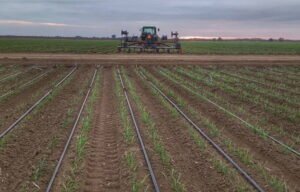
Intercultural operations
The first interculture is given one month after sowing seeds with the help of hoe. As garlic is a closely planted crop , manual weeding with the help of plough or hoe will be tedious and expensive. There is also a risk of damaging the crops .Therefore, chemical herbicides are a better option.
Yield & Harvesting of Garlic
After the seeds are sown and planting is done ,Garlic is ready for harvesting after 130 -150 days. It mainly depends on the cultivar, soil and season.
At a stage ,when the top turns yellowish and starts to dry it is understood that the crop is ready to be harvested.
Early harvests may result in poor quality of the crop. It cannot be stored for long periods if so happens.
The plants are then uprooted with care and tied in small bundles . They are then left for drying in the shade for 2 – 3 days. Curing and drying the bulb makes it hard which improves the quality.
The bulbs are then stored by hanging them on bamboo or by putting them on dry sand.
YIELDING OF CROPS
The yield of garlic depends on many factors . Some of these are soil, climate, cultivar ,fertility of land and crop care. The varieties of longer days yield more than usual. The garlic can yield 40- 100 quintals per hectare depending upon the conditions.
Plant Protection
The most important task that a farmer does in his life is to look after the crops and protect them from pests.
Disease and pest management is something vital that provides good quality yield of bulbs.
There are some diseases in garlic which are caused by viruses. A few of them are as follows:-
- Onion yellow dwarf disease – This is spread by a virus (onion yellow dwarf) . In this the leaves of the crop develop yellow streaks , they crinkle and fall off . The size of the bulb is also small. It can be prevented by using good quality and health seeds.

- Leak yellow stripe – It is spread by the leak yellow stripe virus. It produces mal- formed bulbs .yellow stripes can be seen on the distal parts of leaves. It can be avoided by foliar spraying of carbosulfan (0.2%)
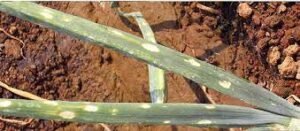
- Irish yellow spot– developed through Irish yellow spot virus. In this , the spot grows bigger and bigger and there are no fine edges of the leaves. A yellow spot can be seen on the leaves.
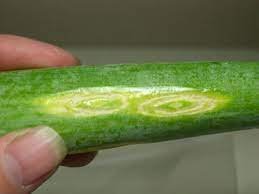
There are also some of the fungal diseases namely:-
- Purple blotch– It is caused by an agent called alternariaporri.
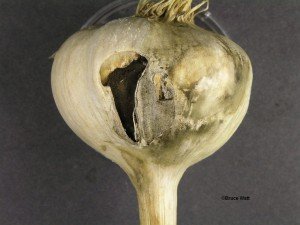
- Stem – phylium blight– It is caused by an agent called stem phyliumvesicarium.

- White rot – It is caused by sclerotiumcepivorum.

Controlling the pests
Thrips cause major loss to the plant . They are mainly observed in dry weather .Blue sticky traps are kept in 6-8 acres. This helps in preventing pests.




